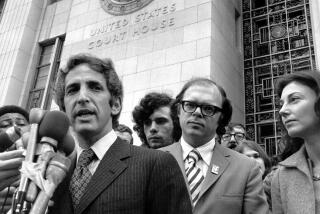Nixon Urged to Choose Between Self and Friends, Papers Show
- Share via
WASHINGTON — Richard M. Nixon was advised in the midst of the Watergate scandal to choose between letting his friends take the heat or heading with them into a “political abyss,” documents released today show.
In one, a memo written by Nixon 1 1/2 years before the break-in, the President asked a top aide to “make a check” of ties between Democratic National Chairman Lawrence F. O’Brien and reclusive billionaire Howard Hughes.
One of the most persuasive theories about the reason for the break-in at Democratic headquarters is that the Republicans wanted information about O’Brien’s links to Hughes.
In the other memo, speech writer Patrick Buchanan told Nixon on May 16, 1973:
“If they (Nixon’s friends) are to survive, they have to do it on their own. The only question extant now, it seems, is whether we are going down as well.”
The Buchanan note and the Nixon memo were among 267,500 pages of Nixon’s personal files that were opened to public scrutiny today after nearly 13 years of legal maneuvering to keep them secret.
On Jan. 14, 1971, Nixon asked for a close watch on O’Brien.
Memo From Air Force One
“It would seem that the time is approaching when Larry O’Brien is held accountable for his retainer with Hughes,” Nixon said in a memo dictated aboard Air Force One.
Nixon added: “There is no question that one of Hughes’ people did have O’Brien on a very heavy retainer for ‘services rendered’ in the past. Perhaps (Charles) Colson should make a check on this.”
The Buchanan note was written about two weeks after Nixon announced the resignations of White House Chief of Staff H. R. Haldeman and domestic counselor John D. Ehrlichman and the firing of White House counsel John Dean.
Dean, at the time, was laying out the details of the Watergate cover-up to prosecutors.
“To be brutally frank, the choice is now between the President and his friends,” Buchanan said in the note. “Haldeman, Dean, Mitchell, Stans, Kalmbach, appear headed, perhaps with Colson in tow, for political abyss. If they are to survive, they have to do it on their own. The only question extant now, it seems, is whether we are going down as well.”
Nixon scrawled on the Buchanan memo, “H&Z--a; very good analysis.”
‘Be Beyond Suspicion’
The file showed that on April 16, 1973, a day after the legal dimensions of the Watergate affair were laid out for him by top Justice Department officials, Nixon prepared a letter announcing resignations of staff members--leaving out names, however. The letter, never used, said his aides “must be beyond suspicion.”
Haldeman and Ehrlichman quit, under Nixon’s pressure, on April 30, 1973, and Nixon called them “the finest public servants I have ever known.”
Both men later wrote bitterly about their firing. The President sent each of them a letter accepting their resignations, appending a few words.
To Haldeman: “We should one day be working together again when this passes.” To Ehrlichman: “I have every confidence in the final outcome for you.” Those letters were dated May 18, two days after the Buchanan memo.
Vice President George Bush, then chairman of the Republican National Committee, optimistically wrote Nixon on July 2--in the midst of the Senate Watergate Committee hearings--that “we’re in fair shape. I expect when we get by those witnesses dragged in by Dean, we’ll be doing OK.”
Exactly two weeks later it was disclosed at the hearings that Nixon had secretly taped conversations, and Nixon’s defenses began crumbling.
On July 20, Nixon made his now-famous statement to “let the others wallow in Watergate; we’re going to do our job.” An aide, Bruce Herschensohn, wrote him a memo saying the word had elect1919510121”was like a boulder falling off the crowd’s shoulders.”
More to Read
Get the L.A. Times Politics newsletter
Deeply reported insights into legislation, politics and policy from Sacramento, Washington and beyond. In your inbox twice per week.
You may occasionally receive promotional content from the Los Angeles Times.










